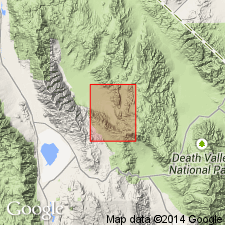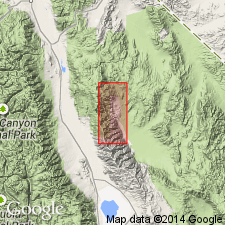
- Usage in publication:
-
- Hunter Mountain quartz monzonite*
- Modifications:
-
- Original reference
- Dominant lithology:
-
- Quartz monzonite
- AAPG geologic province:
-
- Sierra Nevada province
Summary:
Hunter Mountain quartz monzonite. Name applied to map unit of plutonic rocks. Described as principally light-gray medium- to coarse-grained hornblende quartz monzonite but includes wide range of border facies (commonly syenodiorite, monzonite, syenite), pegmatite, aplite, and lamprophyre. Greatest topographic relief of an exposed part is about 4,000 feet in Nelson Range. Plutonic rocks intruded and metamorphosed Bird Spring(?) formation of Pennsylvanian and Permian age and lie nonconformably under continental deposits of late Pliocene or Pleistocene age. Age is Cretaceous(?).
Named from Hunter Mountain in Panamint Range. Exposed continuously from contact at least 8 mi east of quadrangle, across Hunter Mountain and for 17 mi along Nelson Range. Exposure is at least 10 mi broad across Hunter Mountain and southward to Darwin quadrangle, eastern CA.
Source: US geologic names lexicon (USGS Bull. 1200, p. 1841).

- Usage in publication:
-
- Hunter Mountain quartz monzonite*
- Modifications:
-
- Age modified
- AAPG geologic province:
-
- Sierra Nevada province
Summary:
Age of Hunter Mountain quartz monzonite modified from Triassic or Jurassic --to-- Early Jurassic.
Source: Changes in stratigraphic nomenclature, 1969 (USGS Bull. 1324-A, p. A7).
For more information, please contact Nancy Stamm, Geologic Names Committee Secretary.
Asterisk (*) indicates published by U.S. Geological Survey authors.
"No current usage" (†) implies that a name has been abandoned or has fallen into disuse. Former usage and, if known, replacement name given in parentheses ( ).
Slash (/) indicates name conflicts with nomenclatural guidelines (CSN, 1933; ACSN, 1961, 1970; NACSN, 1983, 2005, 2021). May be explained within brackets ([ ]).

